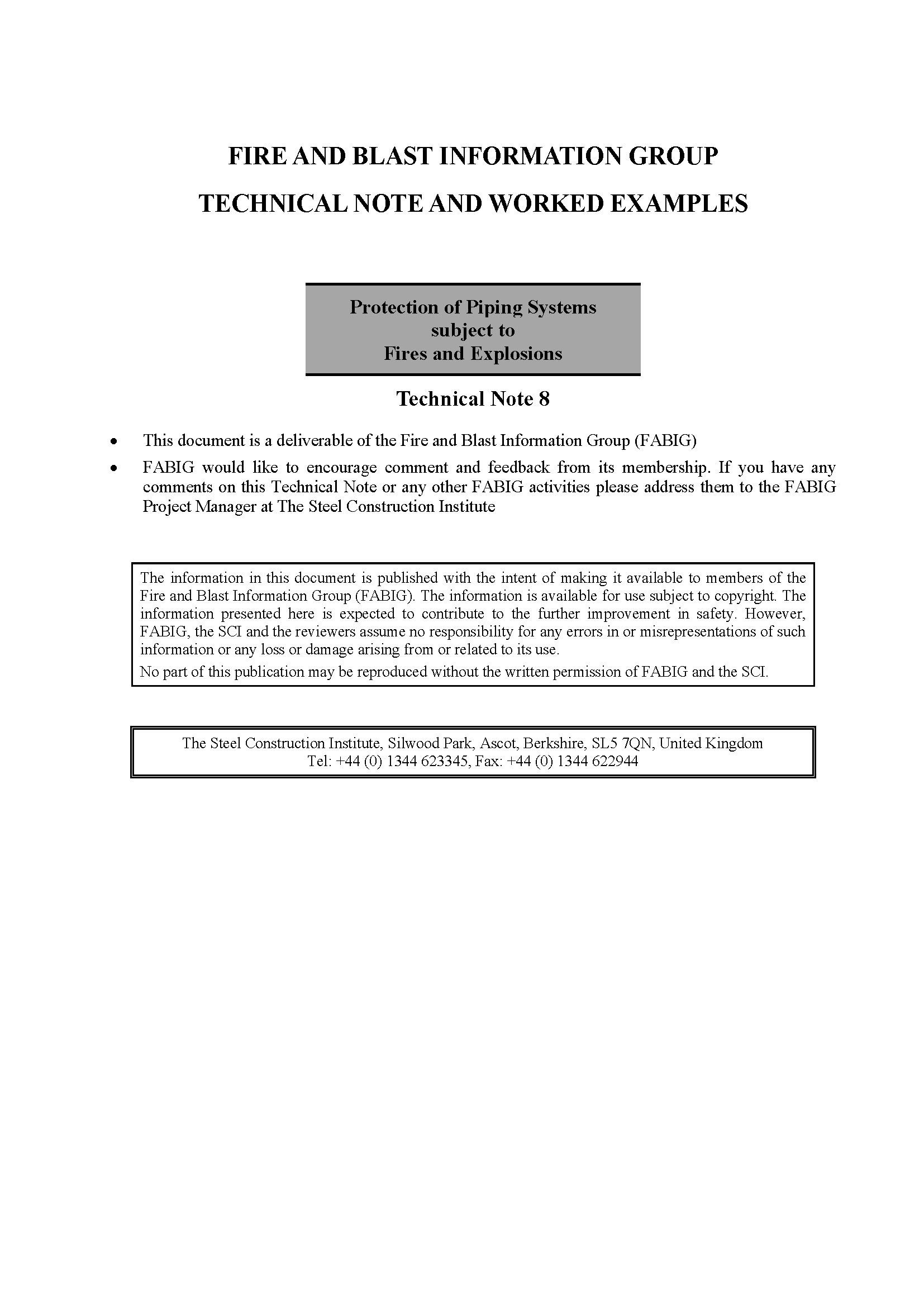Technical Note 08
Protection of Piping Systems subject to Fires and Explosions

FABIG Members: Log-in to access all FABIG resources LOG IN
SUMMARY
The principles of structural design to resist fire and explosions on offshore installations have been extensively described in the Interim Guidance Notes and subsequent FABIG Technical Notes. Much of this guidance is also applicable to land-based petrochemical installations.
Techniques for the design of offshore piping to resist explosions have been described in OTO 1999-046 Explosion Loading on Topsides Equipment, Part 1 Treatment of explosion Loads, Response Analysis and Design. FABIG Technical Note 8 seeks to combine this guidance with the design for fire and to extend the techniques to cover onshore plant design. Guidance on minimising hazard, assessing hazard, on pipe support and pipe rack design is also given. The work follows a review of current industry practice in this area.
It is neither practical nor necessary to design all pipes to withstand explosion and/or fire effects and a two-level criticality rating system is advocated for those pipes that do require treatment.
Three design and analysis methods for explosions are described. The basic Category 1 analysis is a simple static load and code check approach to ASME B31.3. Category 2 is an enhancement of the method, with SDOF analysis to determine and incorporate suitable Dynamic Load Factors. Category 3 is a full MDOF – NLFEA approach for more complex situations. Categories 1 and 2 are illustrated by worked examples.
FOREWORD
EXECUTIVE SUMMARY
ABBREVIATIONS
GLOSSARY
SCOPE OF THIS DOCUMENT
PART A OVERVIEW OF DISCIPLINE ACTIVITIES
- INTRODUCTION
- OVERVIEW OF DISCIPLINE ACTIVITIES
- Introduction
- Description of design process
- Overview of Disciplines
- Development of information with progress of project
PART B HAZARD ASSESSMENT AND PLANT LAYOUT
- HAZARD ASSESSMENT
- Principles of hazard assessment
- Goal setting approach
- Determination of criticality levels for piping
- PLANT LAYOUT
- Overall layout aspects
- Offshore installations
- Onshore plants
- Projectile risk
- Local layout aspects
- Non-Conductive Materials and Minimising Electrostatic Sparking Risk
PART C DESIGN
- EXPLOSION LOADS
- Parameters affecting explosion loading
- Methods used for determining the explosion loading
- DESIGN OF PIPING AGAINST EXPLOSIONS
- Introduction
- Effects of explosions on pipework
- Design flow charts
- Acceptance criteria
- FIRE LOADS
- Introduction
- Fire characteristics to be considered
- Determination of heat fluxes
- Interaction of Fires and Explosions
- DESIGN OF PIPING AGAINST FIRES
- Introduction
- Effects of fire on pipework
- Design of piping systems
- Firewater and other essential safety systems
- Pipe supports
- Flanges, bolts and welds
- Fire protection
- Optimisation of fire protection
- DESIGN OF PIPE SUPPORTS AGAINST FIRES AND EXPLOSIONS
- Introduction
- Types of piping supports
- Guidance for ductile construction
- TYPES OF PIPING AND MATERIAL PROPERTIES
- Standards used for piping and piping material
- Typical materials used
- Required material properties for carrying out blast assessment
- Required material properties for carrying out fire assessment
- OUTSTANDING ISSUES
- Explosions
- Fires
- Supports
- Piping Materials
REFERENCES
APPENDIX 1 Response of piping system subjected to an explosion loading
APPENDIX 2 Response of piping system subjected to fire
Online purchase options:
Non-Members of FABIG are able to purchase PDF copies of the FABIG Technical Guidance documents.